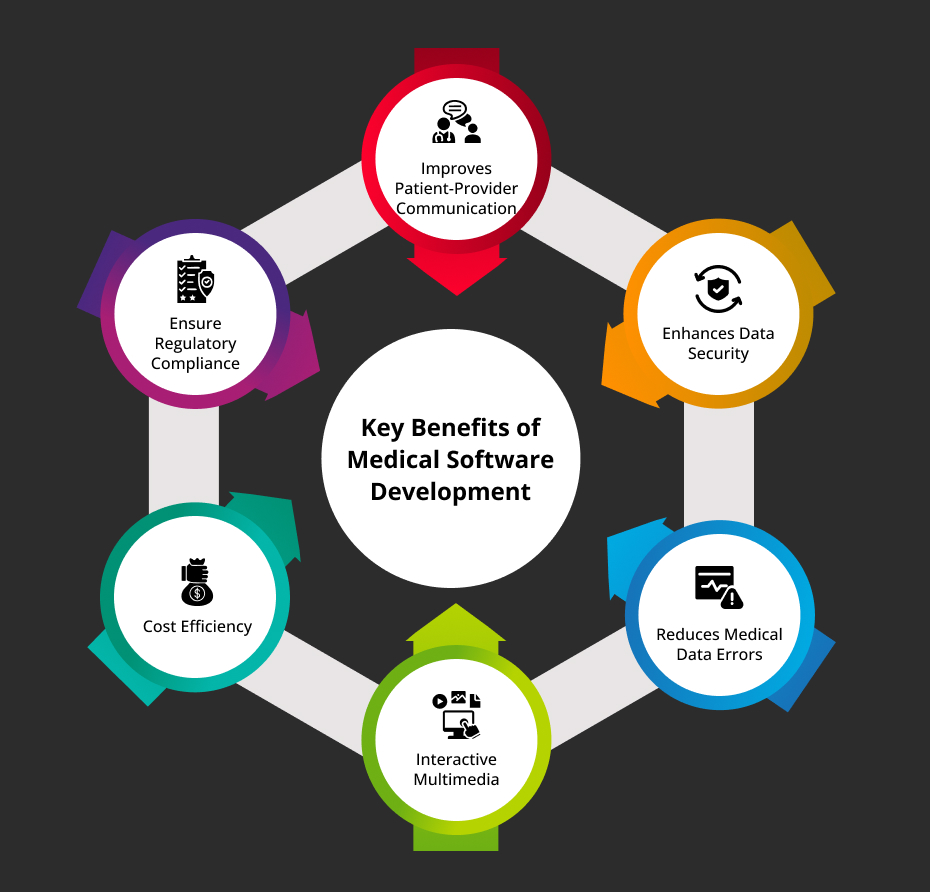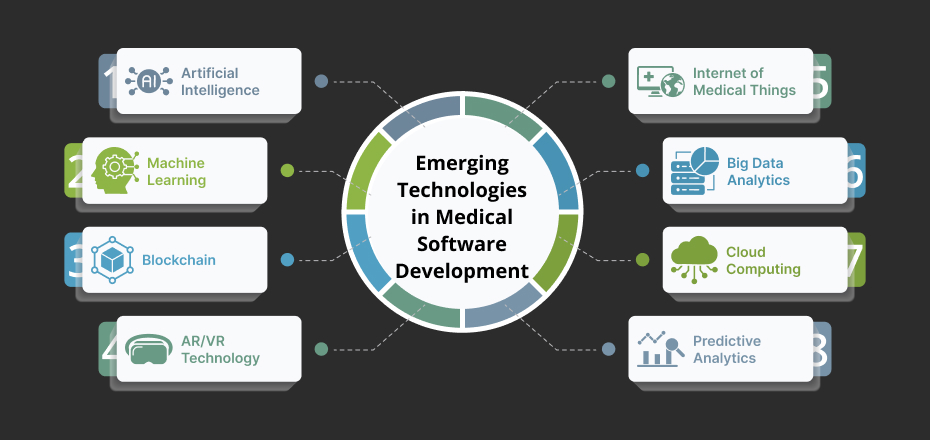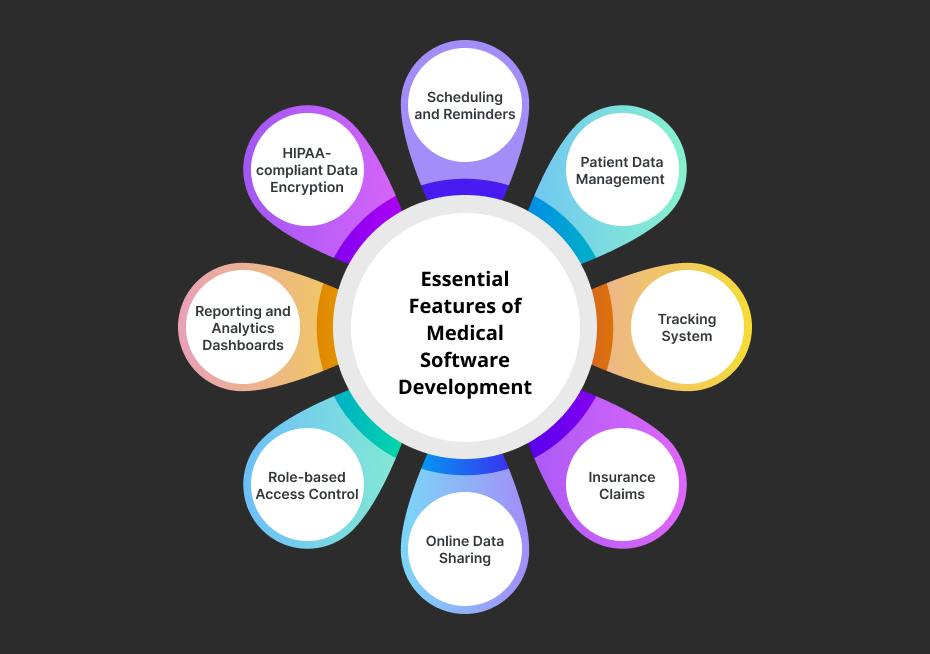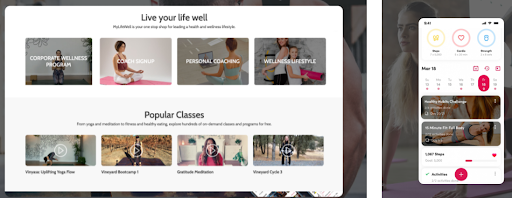The healthcare industry is accelerating at a quantum speed, and medical software is driving this change. From booking appointments to remote patient monitoring, digital tools are becoming essential in how care is delivered.
With the rising demand for smarter, faster, and safer healthcare experiences, more providers are turning to medical software development. Why? Because off-the-shelf solutions just can’t keep up with unique workflows, compliance needs, and patient expectations.
In fact, the global healthcare IT market is expected to reach $1.7 trillion by 2033, demonstrating the rapid growth of digital transformation.
Whether you’re a hospital, clinic, or healthtech startup, building future-ready medical software can improve outcomes, reduce errors, and save costs. In this guide, we’ll walk you through everything you need to know about software development in the medical field. Let’s get it started.
What is Medical Software Development?
Medical software development is the process of creating digital health solutions that help healthcare providers manage, monitor, and improve patient care. It covers everything from hospital management systems to mobile health apps.
Medical software solutions streamline tasks, reduce errors, and support better decision-making. Unlike other software, medical tools follow strict healthcare standards and privacy laws. As healthcare needs evolve, custom medical software development provides easier adaptation and more efficient care delivery across various settings.
11 Types of Medical Software Development Solutions
Selecting the best medical software is a significant decision in healthcare. The correct choice can make your services better and help your staff work more efficiently by streamlining workflows and reducing errors. Below are the most common types of medical software you’ll come across.
1. Electronic Health Record (EHR/EMR) Software
EHR or EMR software stores and manages patient records digitally. They replace paper charts and make patient information easy to access anytime. Additionally, doctors can track medical history, lab results, medications, and more from one place.
EHR software development also helps reduce errors and save time during appointments. It enables better coordination between providers and patient care. It’s a must-have for any modern healthcare practice.
2. Telemedicine Software
Telemedicine software makes virtual healthcare possible. It lets doctors and patients connect through video calls, chats, or phone calls, without needing to visit in person. This is extremely helpful for follow-ups, remote consultations, or treating patients in rural areas.
- Telemedicine software development comes with secure messaging, appointment scheduling, and even payment options.
- With rising demand for convenient care, telemedicine app development helps save time, lower costs, and increase patient satisfaction.
3. Healthcare CRM Software
A healthcare CRM application helps providers manage patient relationships better. It keeps track of appointments, communication, and feedback all in one place. You can also use it to send reminders, follow up on treatments, and personalize outreach.
Plus, healthcare CRM software development helps improve the patient experience by making patients feel heard and cared for. On the backend, staff can easily manage workflows and reduce manual tasks.
4. Medical Imaging Software
Medical imaging applications enable doctors to view and analyze images, including X-rays, MRIs, and CT scans. They can zoom in, measure, and even create 3D models. This helps detect problems early and plan treatments better.
Many healthcare entities use AI in healthcare to highlight issues automatically. They store images securely and make sharing between specialists easier. Whether it’s for diagnosis or surgery preparation, imaging software plays a vital role in clinical decisions.
5. Medical Device Software
Medical device software development helps in controlling healthcare equipment like pacemakers, infusion pumps, or wearables. These apps connect to medical devices or hospital systems to send real-time data. That way, providers can monitor patients remotely and respond faster if something changes.
Since a medical device deals with critical health data, medical device software development services need to follow strict regulations. When done right, it makes care smarter and more responsive.
6. Medical Billing Software
A medical billing application simplifies handling payments by automating coding, invoicing, and insurance claims. Modern health insurance software solutions can also help speed up reimbursements and maintain organized financial records.
With the support of medical billing software development services, healthcare organizations can efficiently track outstanding payments. Built-in compliance features ensure secure management of sensitive patient and financial data.
7. Hospital Management Systems
Hospital management systems bring everything under one roof. From patient records to staff scheduling and billing, it handles it all. They simplify day-to-day operations and help teams work more efficiently.
These systems also reduce paperwork and make it easier to stay organized. Whether it’s a big hospital or a small clinic, this software keeps things running smoothly behind the scenes.
8. Appointment Booking Software
Appointment booking software development makes scheduling simple and fast. Patients can book or cancel visits online without needing to call. On the provider side, it reduces no-shows by sending automatic reminders. It also helps manage calendars and avoid double bookings.
Some tools even let patients choose their preferred time and doctor. That means better convenience, fewer delays, and more satisfied patients.
9. E-Prescription Software
E-prescription application lets doctors send prescriptions straight to pharmacies electronically. It eliminates the need for handwritten notes and reduces errors due to messy handwriting. It also flags possible drug interactions and allergies before the order goes through.
- Patients get their medication faster
- Providers can track what was prescribed and when.
- It supports compliance with modern healthcare standards and facilitates easier record-keeping.
10. Medical Inventory Management Software
Medical inventory management software development helps keep track of all supplies and equipment in real-time. It prevents stockouts and overordering by sending alerts when items run low.
You can easily monitor expiration dates, manage orders, and reduce waste. This means clinics and hospitals never run out of critical items. This software keeps your shelves organized, has never been easier or more important.
11. Medical Education and Training Software
This software supports doctors, nurses, and students in learning and staying updated. It offers interactive modules, virtual simulations, and real-time quizzes. Some even use AR and VR to simulate surgeries and emergency scenarios.
It’s perfect for continuous learning without needing in-person sessions. This software makes medical learning more flexible, engaging, and effective.
Patient-Centric Medical Software Solutions for Operational Excellence
Future-ready software solutions for medical are built with the patient in mind, but also help teams work smarter. From smoother workflows to faster data access, they boost efficiency across the board.
1. Health Information Exchange (HIE)
HIE software allows healthcare providers to securely share patient data across systems. This means quicker access to medical histories, test results, and treatments. It improves coordination and avoids duplicate tests.
2. Remote Patient Monitoring (RPM)
RPM tools let doctors track patient health from anywhere using connected devices. Vital signs, symptoms, or glucose levels can be monitored in real time. This reduces hospital visits and supports early intervention.
3. Clinical Decision Support Systems (CDSS)
CDSS software provides doctors with real-time guidance during diagnosis and treatment. It uses patient data and medical knowledge to flag risks or suggest actions. This leads to safer decisions and fewer errors.
4. mHealth (Mobile Health) Applications
mHealth apps bring healthcare straight to your smartphone. Patients can track health, book appointments, or talk to doctors on the go. mHealth app development makes care more accessible, especially for those in remote areas or with busy lives.
5. Lab Information Management Systems (LIMS)
LIMS helps labs manage samples, track results, and maintain records efficiently. It automates tasks like barcode labeling, data entry, and reporting. This reduces errors and speeds up turnaround times.
Key Benefits of Medical Software Development
Medical application development can offer several advantages in terms of workload tracking. Additionally, it can be used for billing management, keeping records up-to-date, and several other purposes. Let us look at these benefits one by one.

1. Improves Patient-Provider Communication
Software development for healthcare makes it easier for patients and providers to stay connected. From messaging tools to real-time updates, it improves clarity and trust. Everyone stays on the same page, which leads to faster responses, better understanding, and stronger relationships in care.
2. Enhances Data Security
With rising cyber threats, protecting patient data is crucial. Cybersecurity in healthcare uses encryption, access control, and secure cloud storage to keep information safe. It also helps meet privacy laws such as GDPR, HIPAA, HITRUST, and more, allowing providers to focus on care while remaining confident.
3. Reduces Medical Data Errors
Manual records often lead to mistakes. With automated data entry and smart alerts, software development in healthcare helps prevent errors in prescriptions, diagnoses, and patient details. This means safer care, fewer delays, and better outcomes for everyone involved.
4. Interactive Multimedia
From educational videos to virtual anatomy tools, interactive multimedia features make care more engaging. Patients learn better, and providers can explain conditions clearly. It’s especially helpful in training, diagnosis, and patient education.
5. Cost Efficiency
Medical software development helps reduce unnecessary expenses. It reduces paperwork, automates routine tasks, and improves workflow. Over time, this saves healthcare app development cost on labor, admin, and even patient readmissions.
6. Ensure Regulatory Compliance
Staying compliant with healthcare laws is tough, but healthcare software development makes it easier. Built-in checks, secure data storage, and audit trails help meet HIPAA, GDPR, and other regulations. This reduces legal risks and builds trust with patients and partners.
Emerging Technologies in Medical Software Development
We’re living in a digital-first world, and every industry is feeling the shift, including healthcare. With new technologies emerging constantly, digital transformation in healthcare systems is more important than ever. Let’s take a look at the top technologies shaping clinical software development.

1. Artificial Intelligence
AI helps doctors diagnose faster, automate admin tasks, and even personalize treatments. From smart assistants to AI chatbots, AI tools improve both speed and accuracy. In fact, Generative AI in drug discovery is accelerating the identification of potential drug candidates, reducing development time from years to months.
2. Machine Learning
Machine learning in medical software studies large data sets to identify trends, predict patient outcomes, or recommend treatments. The more it learns, the better it gets. This means faster decisions, fewer errors, and a more personalized approach to care.
3. Blockchain
Blockchain for healthcare stores records in a way that’s tamper-proof and easy to verify. That means safer data sharing between hospitals, patients, and labs. It also improves trust and helps prevent fraud, all while ensuring strict privacy compliance.
4. AR/VR Technology
With AR/VR in medical software, doctors can utilize it for surgical simulations, patient education, and even pain management. These tools offer a hands-on experience without real-world risks. They help patients understand complex procedures easily.
5. Internet of Medical Things (IoMT)
IoMT connects medical devices to collect and share patient data in real time. Think wearables, smart monitors, or even connected inhalers. IoT in healthcare improves remote care, early detection, and overall patient monitoring.
6. Big Data Analytics
Big data in healthcare enables hospitals to identify trends, enhance treatments, and make more informed plans. With the right tools, providers can predict outbreaks, track chronic conditions, and make smarter decisions backed by real numbers.
7. Cloud Computing
Cloud computing in medical software allows healthcare data to be stored and accessed securely from anywhere. It supports easy collaboration between teams, better data backups, and lower IT costs. They are flexible and scalable for modern medical software systems.
8. Predictive Analytics
Predictive analytics utilizes data to forecast potential outcomes. It helps doctors catch issues early, plan treatments, and reduce hospital readmissions. With the right models, it can even forecast disease risk before symptoms show.
Custom Medical Software Development Process
Building medical software isn’t just about writing code. It involves careful planning, an intelligent medical software design process, secure architecture, and ongoing updates. Each step plays a role in delivering a reliable, compliant, and user-friendly healthcare solution.
1. Discovery and Requirements Gathering
It all starts with understanding your needs. In this phase, define your goals and identify the must-have features. This helps set a clear roadmap. The better the product discovery phase, the smoother the entire project goes.
2. UI/UX Design for Medical Interfaces
In healthcare, UI/UX design must be clean, intuitive, and accessible for everyone. Use user-friendly layouts, intuitive navigation, and clear visuals. This makes sure doctors, nurses, and patients can interact with the system confidently and efficiently.
3. Architecture Planning
You should choose a future-ready tech stack, plan how the software will scale, and ensure data flows smoothly. Interoperability matters too, so plan for integration with EHRs or lab systems. A solid architecture keeps things fast, secure, and reliable.
4. Development and Integration
Hire a software development services provider that builds the frontend and backend, adds APIs, and connects third-party tools. Integration ensures everything works together like one smooth system.
5. Testing and Validation
From security to performance, nothing goes unchecked. This phase includes usability tests to ensure medical software development works for real users. Bugs get fixed early, and updates are made quickly. This phase ensures the software is stable, safe, and ready for real-world use.
6. Regulatory Certification
Medical software must meet strict standards. Documentation, risk analysis, and audits are part of the process. Getting certified builds trust and ensures your solution is legally ready for launch.
7. Deployment and Maintenance
Once everything is tested and approved, a software developer in medical field will roll out your software, making sure it runs smoothly on all systems. Regular updates, performance checks, and application maintenance ensure your solution stays secure, compliant, and up-to-date over time.
How Much Does It Cost to Build Medical Software?
The cost of medical software development depends on two key factors: project complexity and the location of the development. Below is a breakdown showing how medical software costs can vary based on features, functionality, and geographic region.
Pricing Based on Project Complexity
Project Complexity | Estimated Cost (USD) |
| Basic (MVP) | $20,000 – $50,000 |
| Moderate | $50,000 – $100,000 |
| Complex | $100,000 – $200,000+ |
Pricing Based on Development Location
Location | Estimated Project Cost (USD) |
| USA | $100,000 – $160,000+ |
| UK | $90,000 – $150,000+ |
| UAE | $80,000 – $130,000+ |
| India | $20,000 – $70,000+ |
| Canada | $85,000 – $145,000+ |
| Australia | $90,000 – $150,000+ |
| Germany | $95,000 – $155,000+ |
Essential Features of Medical Software Development
The next significant step in electronic healthcare software is the development of enterprise-level solutions. When EMR, EHR, and CRM systems work seamlessly together, the results can be game-changing. So, let’s explore the must-have features every medical software management system should include.

-
Appointment Scheduling and Reminders
This feature makes it easy for patients to book, reschedule, or cancel appointments. It also sends automatic reminders to reduce no-shows. For staff, it simplifies calendar management.
-
Patient Data Management
Patient data management keeps all medical records in one secure, easy-to-access place. Doctors can quickly view medical history, test results, or treatment plans.
-
Tracking System
A built-in tracking system monitors everything from lab samples to equipment usage. It ensures nothing gets lost and results reach the right hands on time. It also helps with inventory, patient monitoring, and workflow status.
-
Insurance Claims
This feature simplifies the claims process. It automates billing, checks for coding errors, and submits claims to insurers. No more manual paperwork or long delays.
-
Online Data Sharing
Online data sharing lets providers securely exchange patient information. Whether it’s between hospitals, labs, or specialists, everyone stays informed.
-
Role-based Access Control
Role-based access control makes sure the right people see the right data. Doctors, nurses, and admins each have permission based on their job. It boosts security, protects privacy, and ensures compliance.
-
Reporting and Analytics Dashboards
These dashboards turn raw data into useful insights. You can track performance, spot trends, and make smarter decisions. Whether it’s patient outcomes or resource usage, everything is easy to read and customize.
-
HIPAA-compliant Data Encryption
HIPAA compliance application development ensures sensitive information stays safe during storage and transfer. It guards against breaches and keeps your software legally sound.
Compliance and Regulatory Considerations for Medical Software Development
Healthcare software development companies must meet strict standards to protect data and ensure safety. From HIPAA to MDR, following the right regulations helps avoid legal trouble and builds trust with users from the very start.
-
HIPAA (US)
The Health Insurance Portability and Accountability Act (HIPAA) protects patient privacy and data security in the U.S. If your medical software handles personal health information, it must adhere to encryption, access control, and audit log requirements. Staying HIPAA-compliant avoids fines and builds patient trust.
-
GDPR (EU)
The General Data Protection Regulation (GDPR) applies to any healthcare software development used in the European Union. It focuses on giving users control over their personal data. You’ll need clear consent forms, data access options, and strong security measures.
-
FDA (USA)
If your medical software functions like a device or supports clinical decisions, the FDA may regulate it. You’ll need to meet quality standards, submit proper documentation, and sometimes go through approval processes.
-
MDR (EU Medical Device Regulation)
MDR governs medical software used in Europe, especially those with diagnostic or therapeutic functions. It requires classification, clinical evaluations, and technical documentation. The goal is to ensure patient safety and product reliability.
-
HL7 and FHIR Standards
HL7 and FHIR enable smooth communication between different healthcare systems. They standardize how data is shared and stored. This makes integration easier and ensures your software can work with EHRs, labs, and hospitals.
-
ISO 13485 and ISO/IEC 27001
ISO 13485 focuses on quality management for medical devices, including software. ISO/IEC 27001 handles information security. Together, they guide best practices for building secure, reliable software.
Future of Medical Software Development
Technology in healthcare is moving fast. From AI assistants to personalized treatments, the future looks smarter and more connected. Medical applications will keep evolving to support better decisions, faster care, and healthier outcomes. Let’s examine the future trends in software development for healthcare.
1. Personalized Medicine
Medical software development services are moving toward personalized care. Using genetics, lifestyle data, and health history, future systems will suggest treatments tailored to each person. This leads to better results and fewer side effects.
2. AI Agents for Doctors
AI agents will assist doctors with real-time suggestions during diagnosis and treatment. These smart tools can analyze records, flag concerns, and offer next steps, right when it matters most.
3. Increased Interoperability
In the future, systems will talk to each other more easily. Better interoperability means smoother data flow between hospitals, labs, and clinics. No more silos or duplicate tests.
4. Decentralized Data Ownership
Patients will have more control over their own health data. With decentralized systems, they can choose who sees their records and when.
How SparxIT Helps You With Medical Software Development?
As a leading healthcare software development company, we build medical software that’s secure, scalable, and user-friendly. From idea to launch, our medical software developers handle everything, such as compliance, design, integration, and testing.
We follow a transparent process and tailor every solution to your exact needs. Whether you’re building a patient portal, a wellness platform, or a clinical system, we’ve got you covered.

One of our success stories is MyLifeWell, a 360-degree wellness platform we developed. It features a smooth, interactive user experience and delivers wellness content through both a mobile app and a web portal.
With SparxIT, you’re not just getting software. You’re getting a reliable software development services provider that understands healthcare and builds solutions that make a difference.

Partner with Experts
Frequently Asked Questions
What are the key stages in the medical software development lifecycle?







The medical SDLC starts with discovery and planning, then moves to design, development, testing, certification, and deployment. Additionally, ongoing maintenance and updates follow to keep the software secure, compliant, and user-friendly.
What are the main challenges in medical software development?












The primary medical software development challenges include:
- Ensuring data privacy and cybersecurity
- Complex and evolving compliance landscape
- Integration with legacy systems
- UX design for diverse patient and provider groups
- High stakes for failure
What tech stack is best for medical software development?












The technology stack depends on the project. Common choices include React or Angular for frontends, .NET or Node.js for backends, and secure databases like PostgreSQL. Compliance and scalability always guide tech stack selection.
How can I choose the right medical software development company?












To choose a trusted medical application development company, you can do the following things:
- Check industry experience and healthcare domain expertise
- Verify regulatory knowledge and certification capabilities
- Ensure AI Tech stack proficiency
- Security-first development approach
- Check if the company offers post-launch support
How do you ensure HIPAA compliance in custom medical software development?












By using data encryption, access control, audit logging, and secure cloud services. Regular risk assessments, privacy policies, and documentation also help align the software with HIPAA requirements from start to finish.



